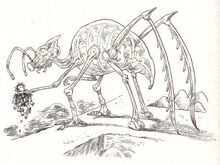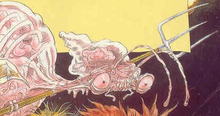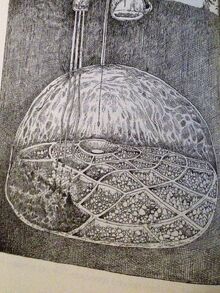Spindlebugs were a unique species of insect in the Edge. They were capable of intelligent thought and speech. Most spindlebugs lived in underground colonies in the Deepwoods, but some found homes elsewhere. These colonies had a special symbiotic relationship with gyle goblin colonies.
Characteristics[]

An adult spindlebug holding an adolescent fourthling

A spindlebug holding a pitchfork
Spindlebugs were very large, capable of picking up members of smaller races such as fourthlings with little difficulty. They had angular heads with many feelers, two antennae, and two huge, multifaceted eyes. They had two arms, with clawed hands, and four legs. Their bodies were pink, and transparent like glass, so their six hearts beating (see Errors and Inconsistencies in the Edge Chronicles), their three lungs rising and falling, their blood flowing, and their food digesting could be seen. Spindlebugs had very long natural lifespans; Tweezel lived for 350 years. Spindlebugs continued to grow throughout their whole lives, so the most ancient spindlebugs were the largest, and the outer casings of ancient spindlebugs became tinged yellow. Young, small spindlebugs were much more manoeuvrable than older, larger ones, which were somewhat slow and ponderous.
Colonies[]
Layout[]

A spindlebug colony located beneath a gyle goblin colony
Spindlebug colonies were located underground in the Deepwoods, usually beneath gyle goblin colonies above them on the surface. Their floors were divided into separate sections by the high walkways that the spindlebugs used to walk around. Most of the sections of the floor were beds where the various organisms that the spindlebugs tended lived, but one was a compost heap, and another was a honey pit. Spindlebug colonies also contained an incinerator to get rid of waste and pests. Spindlebug colonies were connected to the surface by inaccessible (from below) vertical drop shafts over the compost heap, by another inaccessible (from below) vertical tunnel over the honey pit, and by an accessible tunnel leading up. Some light in the colonies came from the surface through the vertical tunnels, but mostly they were lit by the natural, unchanging light of pink fungus.
Activities[]
Tending[]
Spindlebugs tended a few different kinds of creatures in their colonies. They tended slime-moles, pink fungus, and milchgrubs for different purposes. Spindlebugs fed the slime-moles and harvested their mole-glue. They fed, hoed, and raked the pink fungus. They had the milchgrubs eat the pink fungus and convert it into honey, and then they milked the milchgrubs at the honey pit to fill it. When there were intruders in a colony, the spindlebugs would verbally command the milchgrubs to help hunt down the intruders.
Relationship with Gyle Goblins[]
Spindlebug colonies enjoyed a mutually beneficial relationship with gyle goblin colonies. Gyle goblins would forage on the surface in the Deepwoods, and put what they found down one of the drop shafts leading to the compost heap in the spindlebug colony below. The spindlebugs only wanted plants for the compost heap. Their motto was “Vegetable, not animal,” so they would take any animals that ended up in the compost heap to the incinerator. Then, by feeding the pink fungus that the honey-producing milchgrubs ate with the material from the compost, they could fill the honey pit. The grossmother in the gyle goblin colony above would lower a bucket to retrieve honey from the pit, and she would use it to make the substance that she fed to the gyle goblins of the colony. Then they could go out into the Deepwoods to forage again, and the cycle repeated itself.
Notable Spindlebugs[]
Notable Spindlebug Colonies[]
- The Gardens of Light
